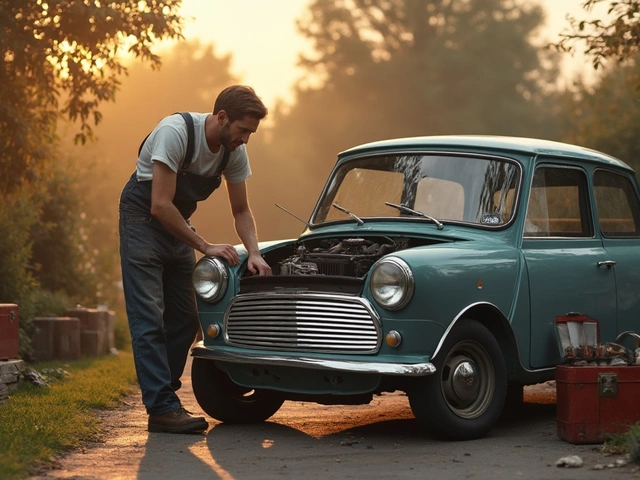Thinking about installing a clutch kit yourself? It can definitely save you some cash, but don't rush to grab that toolbox just yet. It requires a bit of automotive savvy, patience, and, well, some elbow grease.
First off, it’s crucial to know what your clutch kit consists of. Typically, you'll have a clutch disc, pressure plate, release bearing (or slave cylinder for hydraulic systems), and sometimes a pilot bearing. Each plays a part in smoothly transferring power from your engine to the transmission.
Now, before you start, gather all the necessary tools. You’ll generally need a socket set, torque wrench, clutch alignment tool, and maybe even a jack and jack stands, depending on your car's setup. These are must-haves—not nice-to-haves.
- Understanding Your Clutch Kit
- Tools You’ll Need
- Assessing Your Skill Level
- Step-by-Step Guide
- Tips for a Smooth Installation
- Common Mistakes to Avoid
Understanding Your Clutch Kit
The clutch kit isn't just one part—it's a collection of crucial components that help your car change gears smoothly. Think of it as the mediator between your engine and your wheels. But what's actually inside the kit?
The Key Components
Most kits include a clutch disc, pressure plate, release bearing, and sometimes a pilot bearing. Each part plays a role:
- Clutch Disc: This is what handles the friction and connects with the flywheel, allowing torque transfer.
- Pressure Plate: It applies pressure to the clutch disc, helping with the engagement and disengagement of gears.
- Release Bearing: This part helps disconnect power, letting you change gears smoothly. In some cars, you'll have a slave cylinder instead.
- Pilot Bearing: Supports the transmission input shaft, keeping everything centered.
Choosing the Right Kit
One size doesn’t fit all here. You'll need specifics based on your car’s make, model, and even the way you drive. Got an old Honda Civic? You’ll need a different kit than someone driving a performance car.
Here’s a tip: if you’re uncertain, check car forums or consult your mechanic. They can steer you in the right direction. Or better yet, grab your car's manual—it usually lists compatible clutch kit models.
Aftermarket vs OEM
Now here’s where the debate starts. Do you stick with the original equipment manufacturer (OEM) parts, or do you go aftermarket? Some swear by OEM for reliable performance, while others prefer aftermarket options for customization and sometimes cost savings.
If reliability is key, OEM is often recommended, especially for daily drivers. But if you’re looking to tweak performance, an aftermarket clutch might be worth it.
Interesting Stat to Consider
| Component | Average Lifespan (Miles) |
|---|---|
| Clutch Disc | 50,000 to 100,000 |
| Pressure Plate | Similar to clutch disc |
| Release Bearing | Similar lifespan |
Hopefully, this breaks down the essentials, making the clutch installation a bit less intimidating. Knowing your parts mean you're halfway to knowing what to do!
Tools You’ll Need
Before diving into the world of clutch installation, make sure you’ve got all the right tools on hand. The last thing you want is to be stuck halfway through the job, scrambling for a tool you don't have.
Must-Have Tools
Here's a handy list to ensure your clutch kit installation goes off without a hitch:
- Socket Set: This one’s non-negotiable. A decent set will help you tackle those bolts and nuts efficiently.
- Torque Wrench: Ensures you tighten components to the manufacturer's specifications. Over-tightening can spell trouble later on.
- Clutch Alignment Tool: Most clutch kits include one, but it's always good to double-check. It helps line up your clutch disc and pressure plate perfectly.
- Jack and Jack Stands: You'll need to lift your vehicle safely to access the transmission. Never rely solely on a jack!
- Screwdriver Set: Handy for all those smaller screws and components you're bound to encounter.
- Penetrating Oil: Ideal for loosening those stubborn, rusty bolts. It’s a time-saver!
Pro Tips
While the bare essentials will get the job done, there are a few additional items that can make your life a whole lot easier:
- Impact Wrench: Not strictly necessary, but it can cut down time and reduce the effort needed, especially on those tricky, tight bolts.
- Flywheel Holder: If your kit includes a flywheel, this tool holds it in place while you work. Avoiding the wobble is key.
- Transmission Jack: Again, not a must-have, but highly desirable. It stabilizes the transmission during removal and installation — it's all about the balance!
And lastly, here’s a fun fact: using the right tools can reduce installation time by up to 30%! That's an afternoon spent working on your car instead of a full weekend gone.
Assessing Your Skill Level
Before diving into installing a clutch kit, you need to seriously assess your mechanical chops. This isn't like changing a tire—it's quite involved, so getting a handle on your own expertise is a solid first step. Do you have the practical know-how, or is it time to call in the pros?
Understanding the Basics
If you can identify parts of a car engine and have a grasp of basic car repair tasks, you're halfway there. Installing a clutch relies on you understanding how to safely work on and around your transmission. Some folks with good DIY skills might still want to call a buddy with more experience to help out or at least offer advice.
Experience with Tools and Repairs
Have you got experience using torque wrenches, jack stands, or have you tackled more complex repairs like replacing brake pads or performing an oil change? A “yes” indicates you might be ready to take this on. Your garage skills will be tested in line with the complexity of the task. As the folks at Car Mechanics Monthly say,
"Tackling a clutch installation without the right experience is like heading onto the motorway without a map—it might work out, but it's easier if you know what you're doing from the start."
Reflecting on Real-Life Experiences
Consider any previous DIY car projects. How did they go? Did you find yourself Googling every step or did you move through it like a pro? It's all about your comfort levels and, let's face it, the stress you’re willing to handle.
Is It Time to Seek Help?
If you're hesitating because the project sounds daunting, that's okay. Sometimes leaning on an expert or even looking over their shoulder during a clutch kit installation might be best. There's no shame in recognizing when professional help is the smartest choice.
| Skill | Self-assessment |
|---|---|
| Basic Car Repairs | Intermediate or higher |
| Tool Familiarity | Comfortable |
| Experience with Transmission | Preferably Yes |
Ultimately, whether or not you decide to swap out a clutch kit yourself, knowing your skillset helps you plan better or avoid unnecessary mishaps. Either way, you'll end up with a smoothly running vehicle—and perhaps some new knowledge on the side!

Step-by-Step Guide
To make this process a breeze, follow this step-by-step guide for installing a clutch kit. Don't worry; we've got your back!
1. Preparation
Start by making sure your car is parked on a flat surface and securely supported with jack stands. Trust me, safety first!
2. Remove the Transmission
This is the most involved step. Disconnect the battery, then safely remove the driveshaft. Make sure to label the bolts for easy reassembly. Gently remove the transmission from the engine. This might be a two-person job!
3. Remove the Old Clutch
Once the transmission is out of the way, you'll see the old clutch assembly. Remove the bolts holding the pressure plate and set it aside, then slide out the clutch disc.
4. Inspect and Clean
Before installing the new components, inspect the flywheel for damage, and clean it using brake cleaner. A smooth surface is key!
5. Install the New Clutch
Position the new clutch disc and pressure plate using a clutch alignment tool. This step is crucial for ensuring everything lines up correctly. Secure it with bolts and make sure they're tightened to the specified torque.
6. Reattach the Transmission
Ease the transmission back into place, making sure everything aligns. Patience is your friend here—take your time.
7. Test Drive
Once everything is back together, take your car for a test drive. Pay attention to how the clutch feels and listen for any unusual noises. A smooth ride means a successful installation!
Remember, if at any point you feel unsure, it's okay to consult with a professional. Better safe than sorry!
Tips for a Smooth Installation
Getting ready to tackle an install on your clutch kit? Here are some tips to keep it smooth as butter. This isn't just about having the right gear—it's about prepping yourself and your vehicle for the task at hand.
Preparation is Key
Before anything else, check your parts. Make sure your clutch kit includes all necessary components. A missing piece can derail your whole day. Trust me, you don't want to find out halfway through the job!
Keep It Clean
Cleanliness is crucial. Ensure your workspace and tools are clean. Grease and debris can cause issues during installation. Plus, a clean area helps minimize the risk of losing small parts.
Follow the Instructions
Sure, manuals can be a drag, but they’re worth the read. Follow any specific instructions provided with your clutch kit. Manufacturers know their stuff and often share valuable insights.
Take Your Time
There's no medal for speed here. Go at a pace you're comfortable with. Rushing can lead to mistakes, and, honestly, redoing steps isn’t fun.
Check Alignments
When you’re aligning the clutch disc, take extra care. Misalignment can spell disaster for your new clutch, causing premature wear. Use the clutch alignment tool provided.
Inspect Flywheel and Bearings
- Replace or resurface the flywheel if it shows signs of damage.
- Check the condition of the release bearing and pilot bearing; replace if needed.
Neglecting these can lead to issues down the road.
Tighten Properly
Here’s where your torque wrench comes into play. Bolts need a specific torque setting, so tightening ‘til it feels right’ won't cut it here.
Remember, installing a clutch isn’t just a job—it’s an adventure. Go slow and steady, follow these tips, and you’ll be driving off into the sunset with the satisfaction of a job well done.
Common Mistakes to Avoid
Installing a clutch kit can be straightforward if you keep an eye out for common pitfalls. Here are some blunders to avoid, so you won’t be left scratching your head (or worse, your wallet) later.
1. Skimping on Cleaning
Many folks rush the cleaning part, thinking it's not essential. Big mistake! The surfaces need to be spotless. Dirt and grime can affect the clutch’s ability to engage smoothly, leading to premature wear. Always clean the flywheel and mating surfaces thoroughly before fitting everything back together.
2. Ignoring Alignment
A common error is getting the clutch disc alignment wrong. Using a clutch alignment tool isn’t just recommended—it's necessary. An incorrectly aligned clutch can result in a wobbly fit and tricky gear changes.
3. Overlooking Torque Specs
Another one that easily catches DIYers off-guard is torque specs. Under torque can lead to parts coming loose, while over torque can damage the clutch components. Always follow the torque specifications provided for your vehicle model.
4. Forgetting the Pilot Bearing
Many times, the pilot bearing's condition is forgotten during installation. A worn-out bearing can make shifting clunky or noisy. Replace it while everything’s already apart—saves you trouble down the road.
5. Rushing the Job
Finally, take your time. Rushing the job is a recipe for mistakes. Don't let impatience lead to missing small but vital details. Set aside a whole afternoon rather than trying to squeeze the task into a couple of hours.
By steering clear of these mistakes, you set yourself up for a more successful clutch installation experience. That way, your car's performance won't let you down when you're back on the road.


